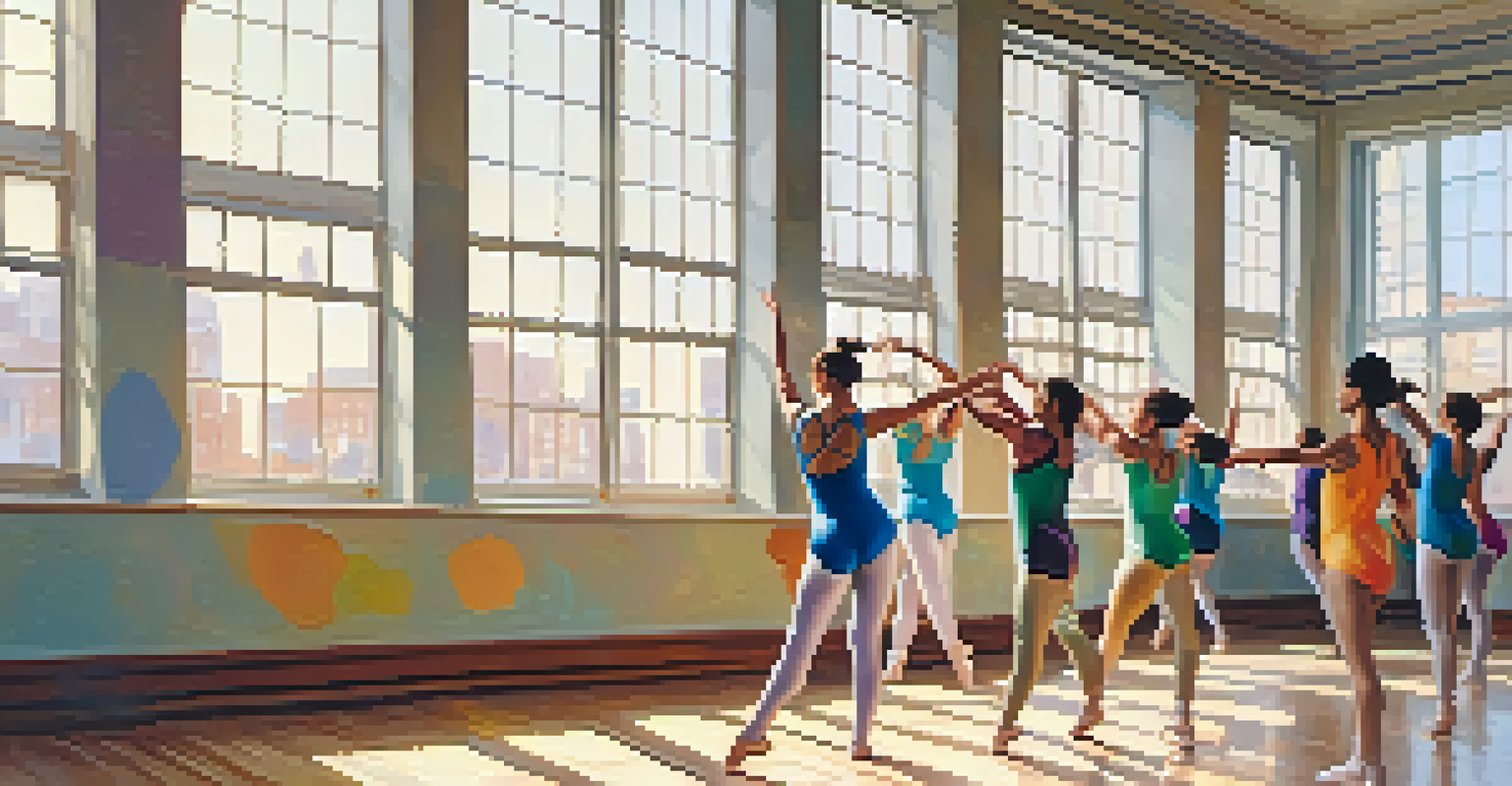Dancer Health and Wellness: Preparing for Competitions

Understanding the Importance of Nutrition for Dancers
Nutrition plays a crucial role in a dancer's performance. A balanced diet fuels the body, providing the energy needed for long rehearsal hours and demanding routines. Dancers should focus on incorporating a mix of carbohydrates, proteins, and healthy fats to ensure optimal performance.
The body achieves what the mind believes.
For instance, whole grains, lean proteins, and plenty of fruits and vegetables should be staples in a dancer's diet. Staying hydrated is also vital; water helps maintain energy levels and prevents fatigue. Neglecting nutrition can lead to decreased performance and increased injury risk.
Consider working with a nutritionist who specializes in sports or dance nutrition. They can tailor a meal plan that meets your specific needs, helping you feel your best during competitions.
The Role of Mental Health in Dance Competitions
Mental health is just as important as physical health for dancers, especially when preparing for competitions. The pressure to perform can lead to anxiety and stress, which can affect not only performance but overall well-being. It's essential to develop coping strategies to manage this stress.

Techniques such as mindfulness and visualization can help dancers stay focused and calm. For example, visualizing a successful performance can boost confidence and reduce anxiety. Regular check-ins with a mental health professional can also provide valuable support and coping mechanisms.
Nutrition Fuels Dance Performance
A balanced diet rich in carbohydrates, proteins, and healthy fats is essential for dancers to maintain energy and reduce injury risk.
Creating a strong support system with fellow dancers and coaches can foster a positive environment. Sharing experiences and feelings can help alleviate pressure and build camaraderie, making the competition experience more enjoyable.
Incorporating Strength Training into Dance Preparation
Strength training is often overlooked in dance training, yet it can significantly enhance performance. By building strength, dancers can improve their stability, control, and overall ability to execute movements. Incorporating exercises that target core, legs, and arms can be beneficial.
You are what you eat, so don't be fast, cheap, easy, or fake.
For instance, exercises like squats, lunges, and planks can increase muscle strength and endurance. It's important to work with a trainer or coach to ensure that the exercises complement dance training rather than detract from it. Proper technique is crucial to avoid injuries.
Additionally, strength training can help dancers recover faster from intense rehearsal schedules. This means more energy for practice and competition, leading to improved performance and confidence on stage.
The Importance of Stretching and Flexibility
Flexibility is a vital component of a dancer's skill set, allowing for greater range of motion and fluidity in movements. Incorporating regular stretching routines can help improve flexibility and prevent injuries. It's important to stretch both before and after dance sessions.
Dynamic stretching before a performance warms up the muscles and prepares them for action, while static stretching afterward helps to cool down and maintain flexibility. Dancers might include stretches such as hamstring stretches, splits, and shoulder stretches in their regimen.
Mental Health Supports Success
Developing coping strategies for stress and anxiety is crucial for dancers, particularly during competition preparation.
Consistency is key when it comes to flexibility training. Dancers should set aside time each day to focus on stretching, as gradual improvements can lead to significant benefits in performance and overall health.
Creating a Pre-Competition Routine
Having a pre-competition routine can help dancers feel grounded and prepared. This routine should include both physical and mental components, such as warming up, rehearsing key movements, and engaging in positive self-talk. A consistent routine can reduce anxiety and boost confidence.
For example, a dancer might start with a warm-up, followed by visualizing their performance and practicing specific sections of their routine. Taking a few moments for deep breathing can also help calm nerves and center focus.
It's essential for each dancer to personalize their routine, as what works for one may not work for another. Experimenting with different elements can help dancers discover what makes them feel most confident and ready to perform.
The Role of Rest and Recovery in Dance Training
Rest and recovery are often undervalued in a dancer's training regimen, yet they are crucial for performance and longevity. Overtraining can lead to fatigue and injuries, ultimately hindering progress. Dancers should prioritize rest days and listen to their bodies.
Incorporating activities such as yoga or light swimming on rest days can promote recovery while keeping the body active. Sleep is also essential; it allows the body to repair and recharge for upcoming rehearsals and competitions.
Rest and Recovery Are Essential
Prioritizing rest days and incorporating recovery activities can significantly enhance a dancer's performance and longevity.
Scheduling regular rest periods into training can improve overall performance. It ensures that dancers are not only physically prepared but also mentally sharp, leading to more successful outcomes in competitions.
Building a Supportive Dance Community
A supportive dance community can significantly impact a dancer's experience, especially during competition preparation. Surrounding oneself with encouraging peers and mentors creates a positive environment that fosters growth and resilience. Collaboration and camaraderie can enhance motivation and morale.
Engaging in group classes or workshops can help dancers build connections and share experiences. These interactions can provide a sense of belonging and reduce feelings of isolation that can accompany the competitive process.

Moreover, coaches and instructors play a vital role in creating this supportive atmosphere. Their guidance and encouragement can help dancers develop not only their skills but also their confidence, leading to a more fulfilling competition journey.